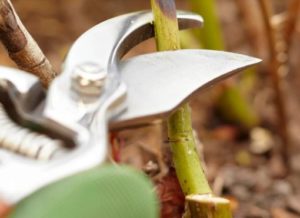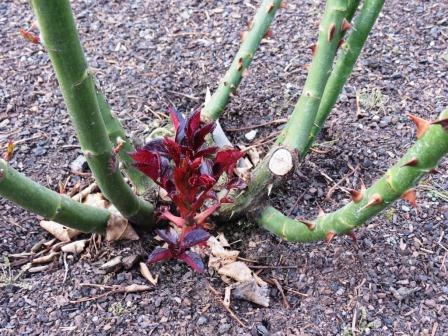If you have roses in your garden and need to know how to care for them over winter, Dr. Jacinta Burke from the Rose Society of Victoria has some great tips.
“Winter is upon us and it is time to get ready for pruning our roses. The roses should have put on plenty of growth over the spring to autumn months, and now need to be rejuvenated for the next season’s growth. Before starting, make sure that your tools have been cleaned and sharpened. Blunt tools make the task more difficult, and more importantly can lead to bruising of the stems, which may result in disease and cause the stems to die back.

Pruning Your Roses
At first, I will discuss the pruning of large-flowered roses. The aim of pruning is to clear out spent growths and to stimulate new vigorous basal shoots (water shoots), which will bear better blooms. Before pruning any rose plant, take a good look at all the main stems. If you have had good growth with new basal shoots, these should be apparent as fresh green stems which have produced flowers at their apex. These should be retained, as they will form the basis of flowering for the next few seasons. Look at the other stems. Any that are old and woody producing spindly growth should be removed at their base where they originally emerged from the graft. A pruning saw is the most appropriate implement to remove as much of the stem as possible. Try not to leave a stub, as this can lead to disease.
Next, look for any stems that are crossing over in the middle of the plant. It is important to keep the centre of the plant open to allow good air circulation, so removal of any stems growing into the centre should be done. Remove any spindly or sickly-looking growths, these will never produce any worthwhile blooms.

Now look at the basal shoots. These are precious and should be retained. If any basal shoots are very young and have not flowered, do not trim them at all, not even the foliage, until at least late September. Inspection of the top of the basal shoots will show that there is a central section and two (occasionally three) lateral sections, which have each borne at least one flower. The lateral sections will have at least one pair of tiny leaflets. At the base of each of these leaflets will be a tiny bud. The central section will not have any leaflets so it should be trimmed back to one of the lateral sections. Trim back the lateral sections to leave one, or at the most, two pairs of leaflets. The buds at the base of these leaflets will ultimately produce some magnificent blooms. Never cut into the main stem of a basal shoot, as the buds along the stem have not yet matured. After some months these buds will mature and shoot, and then the upper part of the stem can be removed.
Previous season’s basal shoots will by now have produced lateral branches. These should be pruned back by about two-thirds to healthy outward facing buds. If there are too many stems on the plant, remove the oldest ones. Do not worry about having a shapely plant. It is much better to aim for having vigorous stems that will produce an abundance of superlative blooms.
Floribunda and Mini-Flora roses can be pruned harder so that only three or four young stems remain. Prune to an outward facing well-developed bud on each stem.
The same general principles apply to the pruning climbers as for pruning large-flowered roses. Using a pruning saw, remove all old spent stems at the base, leaving no stub. Most of these stems will be more than two years old. Also remove any spindly or diseased stems. Stems which were new the previous year will have borne flowers on side shoots. Retain the strongest of these side shoots, cutting them back to one or two buds. Tie the new stems to the support such that they are inclined slightly upward or horizontal. Do not bend the stems below the horizontal, this will result in the ends of the stems producing poor blooms or not growing at all. Take great care while bending the stems as it is easy to tear it out at its base.
Miniatures need to be encouraged to produce new growth. Some miniatures also have a very dwarf habit and can be cut back hard. Miniatures with a larger growth habit such as ‘Irresistible’ and ‘Magic Show’ can be treated like a floribunda, leaving three or four healthy new canes which have been cut back by about two-thirds to a healthy bud.
Planting New Roses
If you have bought bare-root roses make sure that you unwrap them straight away and submerge the roots completely in a bucket of water for 24 hours. Presumably you have already prepared your soil where you are planning to plant your roses. Dig a hole deep enough and wide enough to accommodate the root system. Incorporate some Seamungus pellets into the soil at the bottom of the hole. Take the rose from the bucket of water and place it in the hole such that the scion is about 5cm above the surrounding soil. Do not allow the roots to dry out. Backfill the soil into the hole, ensuring that the scion remains above soil level. Water in the plant with at least half a bucket of Seamungus Liquid diluted according to the manufacturer’s instructions.
If it is not convenient to plant your roses in their permanent spots straight away, then heel them into the soil. To do this, dig a trench deep enough to accommodate the roots. Place the roses side by side into the trench and then backfill with soil. Again, water in well with a Seamungus Liquid solution. The roses will quite happily remain there until you are ready to plant them out permanently. It is probably best not to leave the roses for too long as they will begin to form new roots, which may be damaged when they are dug up to be put in their final sites.
Roses that have been bought already growing in pots can be planted at any time. As before, have your soil prepared and then dig a hole that is wider and deeper than the root ball. Incorporate some Seamungus pellets into the soil at the bottom of the hole. If the roots are growing in a tight ball it will be necessary to tease out the roots. Place the roots into the hole ensuring that the scion is above the surrounding soil by about 5cm. Backfill with soil and then water in with half a bucket of Seamungus Liquid solution.
Pest and Disease Control
After you have finished pruning and planting your roses, it’s time to give your plants a thorough spraying to help prevent pests and diseases. Spray with lime sulphur, making sure that you also spray the soil around the plant as fungal spores and pests and/or their eggs may be hidden there. Two to three weeks later you can spray with a copper and white oil mix. It is important to leave this time between the two sprayings, as the two types of spray are incompatible. It is not necessary to do the second spray each year as there is a risk that copper may build up in the soil and this will be detrimental to the health of your roses. Copper toxicity can result in stunted growth and prevent the uptake of iron. Once copper has built up in the soil it is impossible to remove it, so it is best to prevent the problem occurring in the first place.
Fertilising
About mid-August the eyes on the roses will be swelling and the roots will be becoming active. Now is the time to give your plants a light feed with Sudden Impact for Roses. Try to do this before rain is forecast. If rain is not imminent, water in the fertiliser thoroughly. Do not feed newly planted roses, they have more than sufficient nutrients from the Seamungus that was incorporated into the soil at planting time. Leave feeding of these plants until December, by which time the root systems will have developed sufficiently to make good use of the fertiliser.
Propagation
Why not have a go at propagating your roses from cuttings? It is not too late to take some cuttings in June. Details of how to do this were given in the Rose Society of Victoria’s autumn issue of the Rose News. Remember to use well-ripened stems. Do not use old woody stems or the upper 20-25cm of the stem. You will obtain a better strike rate if you put the cuttings into a propagating medium. This can be bought from a nursery or you can make your own consisting of two parts sharp sand (filter sand), one part peat moss and one part of loose unfed loamy topsoil. Keep moist but not wet”.
🌿 About Seamungus – Seamungus is a soil and plant conditioner, manufactured by combining the very best of composted raw materials – seaweed, fish, humic acid and manure. It is also a health tonic and planting food for all plants including natives, lawns and bare-rooted roses. Seamungus undergoes a unique composting process, specifically developed to stabilise the nutrients, maximise nutrient availability and to ensure the product is free of any parasites, pathogens and weed seeds. Most importantly, the resultant product retains the microbiology necessary for a ‘living’ product. Whilst Seamungus contains a wide range and good levels of plant nutrients, it is perhaps the additional unique properties contained within seaweed that provide the catalyst for providing higher yields of sustained quality.
🌿 About Sudden Impact for Roses – ideal for all flowering and fruiting plants (not just roses), Sudden Impact for Roses combines the best of both worlds. Its organic base provides a full range of plant nutrients in a slow release form, whilst the carefully selected water-soluble nutrients have been added to maximise the performance of each application. Sudden Impact for Roses is endorsed and recommended by the Rose Society of South Australia, the South West Rose Society, the National Rose Society of Australia, Heritage Roses in Australia, The Rose Society of WA, The Rose Society of NSW, The Rose Society of Victoria and the Queensland Rose Society.
To keep up to date with Neutrog’s community news, inspirational stories from home gardeners, new product developments and the best products to use on which plants and when, join the Pooh Bah Club and we’ll email you our monthly newsletter. It’s free to join and you can unsubscribe at any time. We promise not to bombard you with emails!

